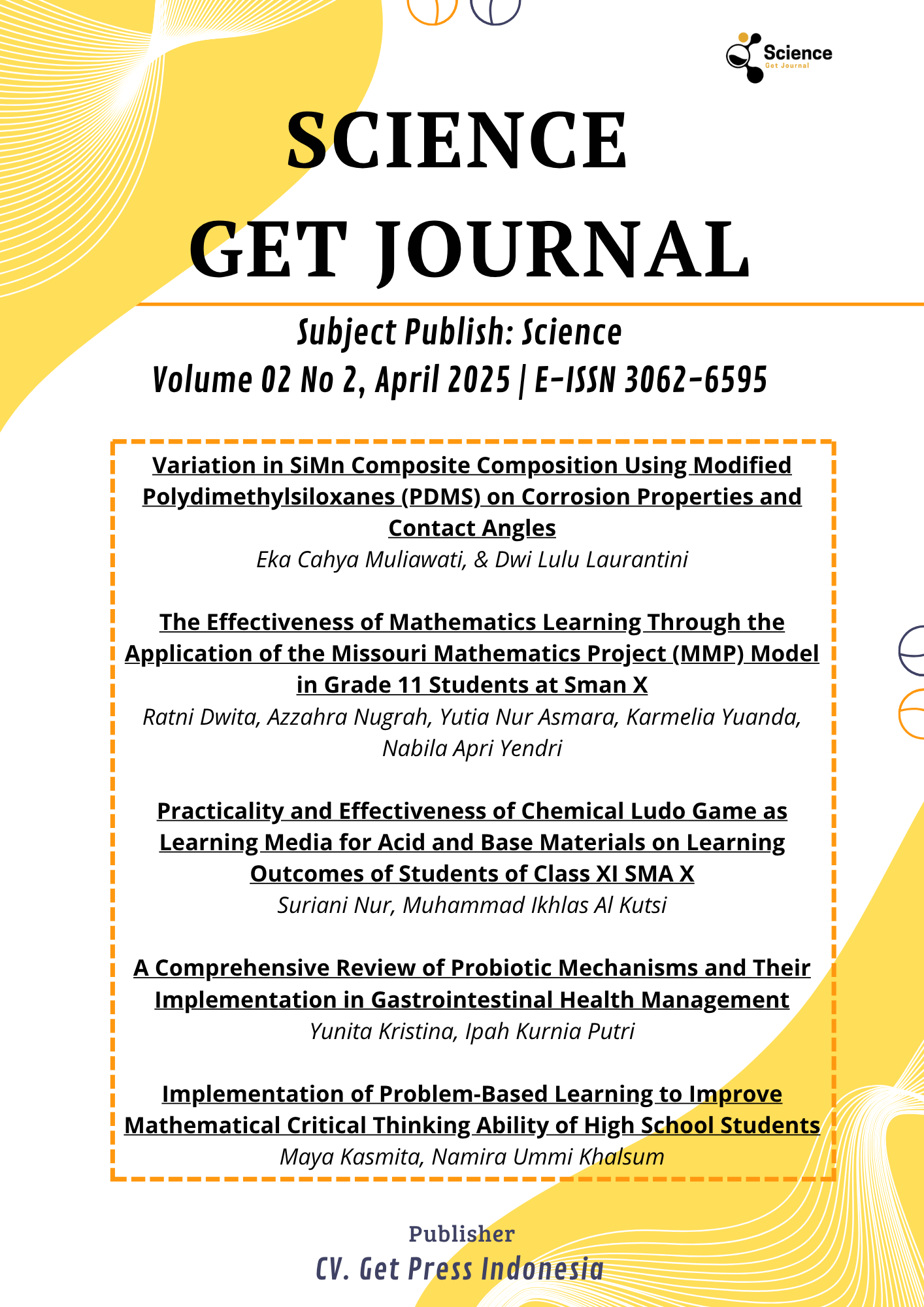Variation in SiMn Composite Composition Using Modified Polydimethylsiloxanes (PDMS) on Corrosion Properties and Contact Angles
DOI:
https://doi.org/10.69855/science.v2i2.134Keywords:
Hydrophobic, Contact Angle, Corrosion Resistance, Polydimethylsiloxanes (PDMS), Silica Oxide (SiO2), Manganese (Mn)Abstract
Corrosion is one of the main challenges faced by advanced industries today because it can cause major losses in terms of safety and economy. One of the common protection methods used to reduce the impact of corrosion is polymer-based coating, which can provide hydrophobic properties on the substrate surface. This study aims to examine the effect of variations in the composition of silica-manganese (SiMn) composites reinforced with polydimethylsiloxane (PDMS) on hydrophobic properties, corrosion resistance, and contact angles. The coating method used is spin coating, with the substrate being a mixture of hard and strong silica and manganese which has corrosion-resistant properties. The SiMn compositions varied were 40%:60%, 50%:50%, and 60%:40%. This study is experimental, using tools such as HEM-3D, XRD, SEM, and FTIR. The coating process was carried out by mixing 2.5 grams of PDMS with silica and manganese powders with a total weight of 1 gram, according to the composition variations. The contact angle test was conducted using a DSLR camera, while the corrosion resistance test was conducted using the immersion method in sulfuric acid with the mass loss method. The results showed that variations in composition affected the contact angle and corrosion resistance of the SiMn-PDMS layer. The composition of 0.6 grams of silica and 0.4 grams of manganese produced the highest contact angle of 120.66⁰, indicating higher hydrophobic properties. Conversely, the composition of 0.4 grams of silica and 0.6 grams of manganese showed the lowest corrosion rate, which was 1.57 cm/hour.
References
Banciu, A., Mihai, M., & Tudorache, F. (2023). Comparative study of the hydrophobic properties of silicon dioxide particles functionalized with different agents. Journal of Optoelectronics and Advanced Materials, 25(1–2), 89–95.
Chungprempree, J., Preechawong, J., & Nithitanakul, M. (2022). Developing an effective and durable film for marine fouling prevention from PDMS/SiO₂ and PDMS/PU with SiO₂ composites. Polymers, 14(20), 4252.
Das, D., & Rout, P. K. (2025). Mechanical and microstructural characteristics of ambient cured fly ash-based geopolymer materials. Biointerface Research in Applied Chemistry.
Elizondo-Villarreal, N., Gandara-Martínez, E., Flores-González, M. A., Martínez-Guerra, E., & Garza-Navarro, M. A. (2024). Synthesis and characterization of SiO₂ nanoparticles for application as nanoadsorbent to clean wastewater. Coatings, 14(7), 919. https://doi.org/10.3390/coatings14070919
Huang, C. C., Wu, T. Y., Chen, Y. S., & Chou, H. Y. (2025). Nano- and micro-SiO₂ with integrated green chemistry-based superhydrophobic coating for robust antifouling and anticorrosion properties. ACS Applied Materials & Interfaces. https://doi.org/10.1021/acsami.4c17284
Jena, G., George, R. P., & Philip, J. (2021). Fabrication of a robust graphene oxide-nano SiO₂-polydimethylsiloxane composite coating on carbon steel for marine applications. Progress in Organic Coatings, 161, 106462. https://doi.org/10.1016/j.porgcoat.2021.106462
Li, C., Jiang, H., Yan, Z., Jing, H., Hu, Z., Zhao, C., & Gao, B. (2025). Designing and structuring MnO₂ coating compositions for efficient and clean zinc electrowinning production. Applied Surface Science.
Lyu, K., Zhang, W., Chen, Y., & Wang, C. (2024). Energy-efficient and advanced electrowinning of metallic manganese within a novel H exchange membrane cell using a Ti/IrO−RuO−SiO₂ anode. Separation and Purification Technology, 347, 127489. https://doi.org/10.1016/j.seppur.2024.127489
Maniscalco, L., Miceli, S., Bono, F., & Matranga, D. (2020). Self-perceived health, objective health, and quality of life among people aged 50 and over: Interrelationship among health indicators in Italy, Spain, and Greece. International Journal of Environmental Research and Public Health, 17(7), 2414. https://doi.org/10.3390/ijerph17072414
Mostashari, A., Sanei, E., & Ganjidoust, H. (2024). The effect of silica-doped graphene oxide (GO-SiO₂) on persulfate activation for the removal of Acid Blue 25. Environmental Science and Pollution Research, 31, 56565–56577. https://doi.org/10.1007/s11356-024-34828-z
Orzolek, B. J., & Kozlowski, M. C. (2021). Separation of food colorings via liquid–liquid extraction: An at-home organic chemistry lab. Journal of Chemical Education, 98(4), 1354–1361. https://doi.org/10.1021/acs.jchemed.0c01286
Su, S., Wang, C., Duan, H., Lv, X., Chen, J., & Jia, H. (2024). Unveiling the role of oxygen vacancy of manganese oxide coating on Ni foam to magnetocaloric catalytic oxidation of toluene. Journal of Hazardous Materials, 480, 136279. https://doi.org/10.1016/j.jhazmat.2024.136279
Wang, X., & Lin, Z. (2021). Robust, hydrophobic anti-corrosion coating prepared by PDMS modified epoxy composite with graphite nanoplatelets/nano-silica hybrid nanofillers. Surface and Coatings Technology, 421, 127440. https://doi.org/10.1016/j.surfcoat.2021.127440
Zhang, Y., Wang, Y., Liu, X., Li, S., Chen, H., & Zhang, D. (2022). A synergistic anti-corrosion system based on durable superhydrophobic F-SiO₂/epoxy coatings and self-powered cathodic protection. Journal of Materials Chemistry A, 10, 20666–20677. https://doi.org/10.1039/D2TA05071D
Sejong University. (2024). Recent advances in the application of nanoparticle-based strategies for water remediation as a novel clean technology–A comprehensive review. Materials Today Chemistry, 40, 102226. https://doi.org/10.1016/j.mtchem.2024.102226
Downloads
Published
How to Cite
Issue
Section
License
Copyright (c) 2025 Science Journal Get Press

This work is licensed under a Creative Commons Attribution 4.0 International License.





